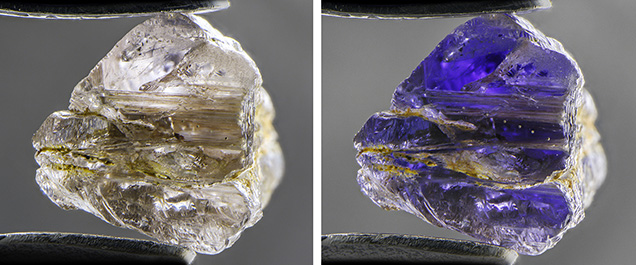Johnkoivulaite: A New Gem Mineral

A new mineral, johnkoivulaite, has been named in honor of John Koivula, a renowned microscopist and preeminent researcher at GIA for more than 40 years. In collaboration with scientists from the California Institute of Technology, Dr. Kyaw Thu of Macle Gem Trade Laboratory, and Nay Myo, a gem dealer from Mogok, GIA researchers described johnkoivulaite, which the International Mineralogical Association (IMA) formally accepted as a new mineral species on September 6, 2019.
The world’s first specimen of johnkoivulaite was reportedly uncovered from the Pein Pyit mining area of Mogok in Myanmar. It subsequently passed through the hands of Nay Myo, a local gem dealer. When the 1.16 ct stone (figure 1) could not be identified, Nay Myo suspected he had encountered a new mineral and had the sample sent to GIA for identification. When the researchers first examined the sample and realized its unique gemological properties, GIA made arrangements to purchase the unusual stone from Nay Myo so that additional advanced testing could be performed and the sample could be deposited in the GIA museum. Once the type specimen was housed in the museum (one of IMA’s requirements for describing a new mineral), the team was able to submit a new mineral proposal. According to IMA guidelines, a new mineral can be named in recognition of a person’s significant scientific contributions to the field of mineralogy. This one was named in honor of John Koivula’s lifelong efforts to advance the sciences of mineralogy and gemology.
Single-crystal X-ray diffraction (XRD) analysis was performed in collaboration with researchers at the California Institute of Technology and indicated a hexagonal crystal structure that was very similar to beryl and other members of the beryl group such as pezzottaite. Chemical analysis by LA-ICP-MS and EPMA identified enrichment in cesium, boron, and magnesium and confirmed johnkoivulaite’s membership in the beryl family, with its ideal end-member formula as Cs(Be2B)Mg2Si6O18. Standard gemological testing gave a refractive index of 1.608, with a birefringence too low to accurately measure, a specific gravity of 3.01, a hardness of 7½, a conchoidal fracture, vitreous luster, and no reaction to long-wave or short-wave UV. Especially notable is johnkoivulaite’s strong pleochroism from deep violet to nearly colorless when observed with polarized light (figure 2).


John I. Koivula (figure 3) developed an interest in minerals and particularly their inclusions during childhood, when he found a quartz crystal with pyrite inclusions in North Bend, Washington. From there, Koivula earned degrees in geology and chemistry before working as an exploration geologist. In the 1970s, his career changed direction when a friend suggested the Graduate Gemologist program at GIA. He joined GIA in 1976 and began publishing gemological articles and short notes while refining his photomicrography techniques. In 1986, he co-authored with Edward J. Gübelin the immensely popular Photoatlas of Inclusions in Gemstones, which was followed by two additional volumes. Koivula also wrote The Microworld of Diamonds and co-authored Geologica with Robert Coenraads. Other highlights of his career include winning first place in Nikon’s Small World Photomicrography competition in 1984, receiving the AGS’s Robert M. Shipley Award in 1996, and being named one of JCK magazine’s 64 Most Influential People in the Jewelry Industry in the 20th Century. In 2002, he was awarded the AGA’s Antonio C. Bonanno Award for Excellence in Gemology. Mr. Koivula also received GIA’s Richard T. Liddicoat Award for Distinguished Achievement in 2009 for his contributions to gemology.
After more than 40 years in the industry, Mr. Koivula still regularly contributes to gem and mineral research and is now a contributing editor for G&G’s Micro-World column.
The discovery of a new mineral is a rare and exciting occasion for the gemological community. It is a special honor for the authors to be able to name this mineral after such a prominent and well-deserving gemologist.
.jpg)


